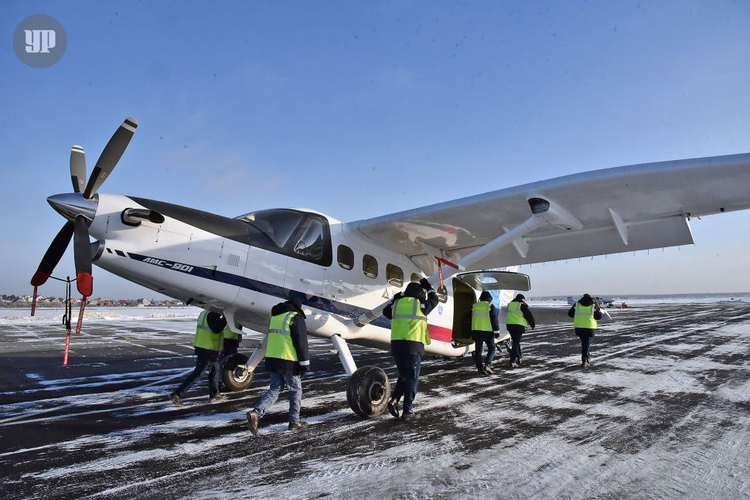F-14ATomcat
ACCESS: Secret
- Joined
- 26 May 2024
- Messages
- 461
- Reaction score
- 879
Problems with the Baikal aircraft
February 21st, 23:22
As reported by the Kommersant newspaper in the article by Aigul Abdullina “Clouds are gathering over Baikal. The replacement of the “kukuruznik” will be replaced by a “kukuruznik”, the project to create a light multi-purpose turboprop aircraft “Baikal” may be frozen or transferred to S7 Group. This is due to the design problems of the aircraft, the elimination of which, according to Kommersant’s sources, may take up to five years. As a temporary alternative, a re-engined An-2 is being considered in the delivery program until 2030. The production of the engine required for this will cost, according to estimates by the United Engine Corporation (UEC), 1.8 billion rubles, while the modification of the “Baikal”, according to Kommersant’s sources, is at least five times more expensive.

The first flight prototype of the LMS-901 Baikal aircraft, February 2023 (c) Boris Yarkov / Uralsky Rabochy
( Collapse )
Fog over Baikal
As Kommersant has learned, the Ministry of Industry and Trade is deciding the issue of re-motorizing the An-2 amid problems with the light multipurpose turboprop aircraft Baikal (LMS-901), which was supposed to take the place of the outdated "maize". Several Kommersant sources in the industry, including those close to the Ural Plant of Civil Aviation (UZGA), insist that the fate of the Baikal project has not yet been decided. In the fall, it was reported that the delivery dates would be shifted to 2026. But according to Kommersant’s sources, the aircraft requires design modifications with a realistic deadline of three to five years.
A number of “dramatic errors” were made during the design of the aircraft, which have only now been finally revealed, claims a Kommersant source close to the Ministry of Industry and Trade: “The aircraft essentially needs to be reassembled.”
He and three other Kommersant sources note that problems with stability at low speeds, high forces on the control stick, as well as the need to increase the tail unit, move the tail wheel, and rework the chassis have been identified.
According to two Kommersant sources, UZGA has requested additional funding from the Ministry of Industry and Trade to modify the aircraft (according to one of them, about 10 billion rubles). It is unknown whether the funds have been approved. One of Kommersant’s sources close to the Ministry of Transport believes that the Baikal program could be “painlessly closed” after an alternative solution is found: “Perhaps the plant will be allowed to concentrate on the Ladoga and Osvey (a Russian-Belarusian project), which the An-2 will fly to market before it is launched.” A source close to the Ministry of Industry and Trade reported that it may not be a matter of the final closure of the program, but of transferring production to S7 Group. The decision to consider this option was recorded following a meeting at the Ministry of Industry and Trade at the end of December. Kommersant sent a request to S7. The office of Yuri Trutnev, who proposed finding another contractor for Baikal, forwarded Kommersant’s questions to the Ministry of Industry and Trade. The department and UZGA did not answer whether work on Baikal would continue. According to Kommersant, the United Engine Corporation (part of Rostec) will resume production of the TVD-10B engine for the An-2 aircraft on behalf of the Ministry of Industry and Trade.
According to Kommersant’s sources, about 1.8 billion rubles will be needed for these purposes, according to UEC estimates. A Kommersant source close to Rostec confirmed work on the TVD-10B, but the state corporation and UEC declined to comment on the situation.
The Soviet turboprop engine TVD-10B was developed in Omsk in 1965. It was produced for the An-28, and is to be replaced by the VK-800 produced by UZGA. The timing of serial deliveries of the VK-800 is still in question, Kommersant’s sources specify, in connection with which a decision was made to restore the TVD-10B at the site of the UEC-Saturn branch in Omsk. The head of SibNIA (the current developer of the An-2) Vladimir Barsuk clarified to Kommersant that the institute is currently working on the possibility of installing the TVD-10B engines already in operation on the An-2 before restoring production in Omsk. According to him, this could take about one and a half to two years.
The issue of the status and prospects of the Baikal production and the search for a temporary alternative in the KPGA (comprehensive program for the development of the aviation industry until 2030) was discussed by the presidential envoy to the Far Eastern Federal District Yuri Trutnev at the end of September. According to the minutes of the meeting, the Ministry of Industry and Trade was instructed to work out the issue of the volume and sources of financing for the re-engining of the TVS-2MS (a modification of the An-2 from Rusaviaprom with American engines) and its inclusion in the KPGA when replacing the engines with domestic ones. Rusaviaprom CEO Alexey Kryukov told Kommersant that the decision on financing and including the aircraft in the KPGA has not yet been made. A Kommersant source close to the government clarified that these issues will be discussed only when it is clear whether it will be possible to operate the An-2 in the passenger version.
On the way out of the "maize"
According to the minutes of the meeting with Mr. Trutnev, Rosaviatsia was instructed to ensure certification of the An-2 by the end of 2024, and TVS-2MS in the first quarter of 2025.
The aircraft is currently undergoing certification

 bmpd.livejournal.com
bmpd.livejournal.com
February 21st, 23:22
As reported by the Kommersant newspaper in the article by Aigul Abdullina “Clouds are gathering over Baikal. The replacement of the “kukuruznik” will be replaced by a “kukuruznik”, the project to create a light multi-purpose turboprop aircraft “Baikal” may be frozen or transferred to S7 Group. This is due to the design problems of the aircraft, the elimination of which, according to Kommersant’s sources, may take up to five years. As a temporary alternative, a re-engined An-2 is being considered in the delivery program until 2030. The production of the engine required for this will cost, according to estimates by the United Engine Corporation (UEC), 1.8 billion rubles, while the modification of the “Baikal”, according to Kommersant’s sources, is at least five times more expensive.

The first flight prototype of the LMS-901 Baikal aircraft, February 2023 (c) Boris Yarkov / Uralsky Rabochy
( Collapse )
Fog over Baikal
As Kommersant has learned, the Ministry of Industry and Trade is deciding the issue of re-motorizing the An-2 amid problems with the light multipurpose turboprop aircraft Baikal (LMS-901), which was supposed to take the place of the outdated "maize". Several Kommersant sources in the industry, including those close to the Ural Plant of Civil Aviation (UZGA), insist that the fate of the Baikal project has not yet been decided. In the fall, it was reported that the delivery dates would be shifted to 2026. But according to Kommersant’s sources, the aircraft requires design modifications with a realistic deadline of three to five years.
A number of “dramatic errors” were made during the design of the aircraft, which have only now been finally revealed, claims a Kommersant source close to the Ministry of Industry and Trade: “The aircraft essentially needs to be reassembled.”
He and three other Kommersant sources note that problems with stability at low speeds, high forces on the control stick, as well as the need to increase the tail unit, move the tail wheel, and rework the chassis have been identified.
According to two Kommersant sources, UZGA has requested additional funding from the Ministry of Industry and Trade to modify the aircraft (according to one of them, about 10 billion rubles). It is unknown whether the funds have been approved. One of Kommersant’s sources close to the Ministry of Transport believes that the Baikal program could be “painlessly closed” after an alternative solution is found: “Perhaps the plant will be allowed to concentrate on the Ladoga and Osvey (a Russian-Belarusian project), which the An-2 will fly to market before it is launched.” A source close to the Ministry of Industry and Trade reported that it may not be a matter of the final closure of the program, but of transferring production to S7 Group. The decision to consider this option was recorded following a meeting at the Ministry of Industry and Trade at the end of December. Kommersant sent a request to S7. The office of Yuri Trutnev, who proposed finding another contractor for Baikal, forwarded Kommersant’s questions to the Ministry of Industry and Trade. The department and UZGA did not answer whether work on Baikal would continue. According to Kommersant, the United Engine Corporation (part of Rostec) will resume production of the TVD-10B engine for the An-2 aircraft on behalf of the Ministry of Industry and Trade.
According to Kommersant’s sources, about 1.8 billion rubles will be needed for these purposes, according to UEC estimates. A Kommersant source close to Rostec confirmed work on the TVD-10B, but the state corporation and UEC declined to comment on the situation.
The Soviet turboprop engine TVD-10B was developed in Omsk in 1965. It was produced for the An-28, and is to be replaced by the VK-800 produced by UZGA. The timing of serial deliveries of the VK-800 is still in question, Kommersant’s sources specify, in connection with which a decision was made to restore the TVD-10B at the site of the UEC-Saturn branch in Omsk. The head of SibNIA (the current developer of the An-2) Vladimir Barsuk clarified to Kommersant that the institute is currently working on the possibility of installing the TVD-10B engines already in operation on the An-2 before restoring production in Omsk. According to him, this could take about one and a half to two years.
The issue of the status and prospects of the Baikal production and the search for a temporary alternative in the KPGA (comprehensive program for the development of the aviation industry until 2030) was discussed by the presidential envoy to the Far Eastern Federal District Yuri Trutnev at the end of September. According to the minutes of the meeting, the Ministry of Industry and Trade was instructed to work out the issue of the volume and sources of financing for the re-engining of the TVS-2MS (a modification of the An-2 from Rusaviaprom with American engines) and its inclusion in the KPGA when replacing the engines with domestic ones. Rusaviaprom CEO Alexey Kryukov told Kommersant that the decision on financing and including the aircraft in the KPGA has not yet been made. A Kommersant source close to the government clarified that these issues will be discussed only when it is clear whether it will be possible to operate the An-2 in the passenger version.
On the way out of the "maize"
According to the minutes of the meeting with Mr. Trutnev, Rosaviatsia was instructed to ensure certification of the An-2 by the end of 2024, and TVS-2MS in the first quarter of 2025.
The aircraft is currently undergoing certification

bmpd
bmpd - the new blog in LiveJournal. There should be new interesting records soon.
 bmpd.livejournal.com
bmpd.livejournal.com

